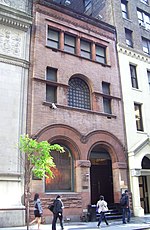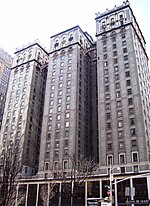The Cutting Room
The Cutting Room is a music venue in New York City that was open at 19 West 24th Street from late 1999 through January 2009 for music of all varieties and reopened at the beginning of 2013 in a new location at 44 East 32nd Street. It was co-owned since its founding by actor Chris Noth and Berklee College of Music alumnus Steve Walter.Among those who have performed at The Cutting Room are Lizzy Grant, Norah Jones, Sheryl Crow, Gwyneth Paltrow, Kid Rock, Vanessa Carlton, Lady Gaga, Sandra Bernhard, Billy Joel, Mark Kostabi, Mini-Kiss, Edward W. Hardy, The Shells, David Duchovny and Gillian Anderson.Noth met his wife Tara Lynn Wilson while she was working at The Cutting Room; the two had a boy (Orion Christopher Noth) in January 2008.
Excerpt from the Wikipedia article The Cutting Room (License: CC BY-SA 3.0, Authors).The Cutting Room
East 32nd Street, New York Manhattan
Geographical coordinates (GPS) Address External links Nearby Places Show on map
Geographical coordinates (GPS)
| Latitude | Longitude |
|---|---|
| N 40.745936111111 ° | E -73.982905555556 ° |
Address
East 32nd Street 44
10016 New York, Manhattan
New York, United States
Open on Google Maps






